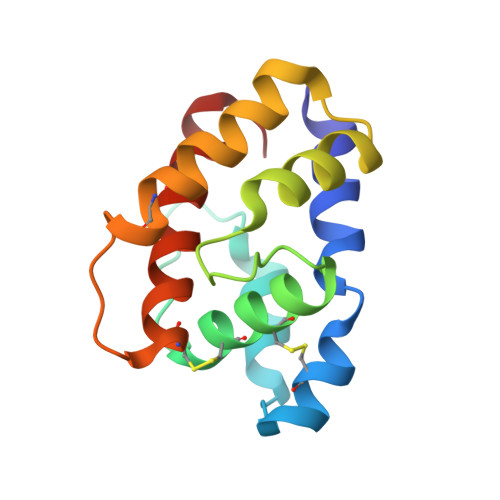Dynamic conformational equilibria in the physiological function of the Bombyx mori pheromone-binding protein.
Michel, E., Damberger, F.F., Ishida, Y., Fiorito, F., Lee, D., Leal, W.S., Wuthrich, K.(2011) J Mol Biology 408: 922-931
- PubMed: 21396939
- DOI: https://doi.org/10.1016/j.jmb.2011.03.008
- Primary Citation of Related Structures:
1XFR - PubMed Abstract:
The Bombyx mori pheromone-binding protein (BmorPBP) undergoes a pH-dependent conformational transition from a form at basic pH, which contains an open cavity suitable for ligand binding (BmorPBP(B)), to a form at pH 4.5, where this cavity is occupied by an additional helix (BmorPBP(A)). This helix α7 is formed by the C-terminal dodecapeptide 131-142, which is flexibly disordered on the protein surface in BmorPBP(B) and in its complex with the pheromone bombykol. Previous work showed that the ligand-binding cavity cannot accommodate both bombykol and helix α7. Here we further investigated mechanistic aspects of the physiologically crucial ejection of the ligand at lower pH values by solution NMR studies of the variant protein BmorPBP(1-128), where the C-terminal helix-forming tetradecapeptide is removed. The NMR structure of the truncated protein at pH 6.5 corresponds closely to BmorPBP(B). At pH 4.5, BmorPBP(1-128) maintains a B-type structure that is in a slow equilibrium, on the NMR chemical shift timescale, with a low-pH conformation for which a discrete set of (15)N-(1)H correlation peaks is NMR unobservable. The full NMR spectrum was recovered upon readjusting the pH of the protein solution to 6.5. These data reveal dual roles for the C-terminal tetradecapeptide of BmorPBP in the mechanism of reversible pheromone binding and transport, where it governs dynamic equilibria between two locally different protein conformations at acidic pH and competes with the ligand for binding to the interior cavity.
- Institute of Molecular Biology and Biophysics, ETH Zurich, 8093 Zurich, Switzerland.
Organizational Affiliation:
















